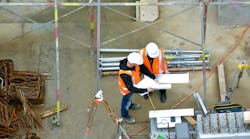The U.S. Department of Transportation's Federal Highway Administration (FHWA) presented its 2006 Utility Outstanding Achievement Award to Frank Huber, P.E., senior technical specialist at Edwards and Kelcey, Morristown, N.J., for his work on the New Jersey Route 21 reconstruction project in Newark. The award cites Huber's innovative approach to subsurface work performed during the nearly $100 million Route 21 reconstruction of a vital 2.2-mile stretch of the highway that runs through Newark's business district.
Redesigning the roadway required relocating and improving the system of underground utilities, including layers of electric, water, gas, telephone, fiber-optic communications, and combined sewer lines, which comprise approximately 250,000 linear feet of utilities that have been installed cumulatively since the 1800s. Complicating matters was the likelihood of encountering unrecorded subsurface non-utility objects. The presence of rocks, debris, and structures, such as unmapped cellar extensions, made installing new lines difficult.
To avoid costly project delays during relocation efforts, Huber developed a technique called “test excavation.” The process entails removing selected sections of pavement and the ground beneath it where utilities are to be installed. If obstructions are discovered and determined to be immovable, the engineer redesigns the alignment of pipes and conduits to avoid the obstructions before the utilities are installed. Huber credits the test excavation process as the reason the project was completed on schedule. “We did our best with the technology we had, but this new component made all the difference,” he says. “We built the new process right into the construction contracts, which helped ensure adherence to the schedule.”
The FHWA selected the Route 21 project from entries submitted nationwide for the 2006 FHWA Excellence in Utility Relocation and Accommodation Award. Six experts in utility relocation and accommodation evaluated the entries. Huber was cited for “implementing four innovative procedures, never before used, that expedited design and minimized construction delays.” In particular, the innovations included minimizing subsurface uncertainty, expediting utility design schedule, minimizing utility alignment conflicts, and maintaining construction schedule control.

